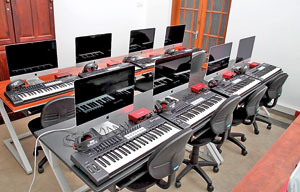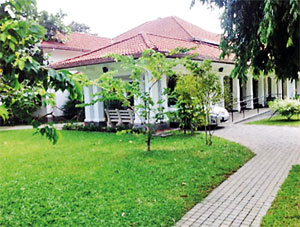Sooriya Village: Embracing all forms of art
 The gates open into a spacious garden, which leads to an elegant space, that fits at No 49 Skelton road, Colombo 5. It was a concept which initially took shape at the back of Sanchitha Wickremesooriya’s mind after many changes, experiences, travels, conversations and performances. And finally on Friday (Sept. 9), Sooriya Village will open its doors.
The gates open into a spacious garden, which leads to an elegant space, that fits at No 49 Skelton road, Colombo 5. It was a concept which initially took shape at the back of Sanchitha Wickremesooriya’s mind after many changes, experiences, travels, conversations and performances. And finally on Friday (Sept. 9), Sooriya Village will open its doors.
The village is essentially a hub for musicians in South Asia, and Sanchitha hopes that it will act as a gateway between the Western World and South Asia. “I want it to facilitate collaborations between artistes of various forms of arts, to create something new and push the boundaries of art in the nation. Artistes at the end of the day are all creative minds and banding them together can only help their cause,” he tells us.
Sanchitha comes from a family that founded and ran the Sooriya Label, the pioneer in producing popular music in Sri Lanka during the 60’s, 70’s and 80’s. Today, the label once again enters the industry,bringing together artists of all disciplines under one roof to work together.
Sooriya Village provides them with the facilities needed to create these collaborative efforts and intends to expose them to various art forms from around the world. The facility is equipped with a Recording Studio, two Rehearsal Suits for the performance arts (one completed and the other still under construction), a Practice Space for Visual Arts, a library dedicated to the arts, a technology/lecture/media room, a restaurant guided by renowned chef “Koluu”, which could host up to 100 people, a co shared store between the “Sooriya” Label and “The Yamaha Music Centre”, a private suite, dormitory facilities (under construction) and gig space.

Being a musician himself, Sanchitha’s journey began at the age of four under the guidance of Mary Anne David for vocals. He followed up with teachers such as Mithrani Smith and Priyani Fernando for piano, and Dian Fernando for both violin and piano thereafter.
“My family, from a young age had immersed me in music and thus my passion for it grew with time,” he tells us. He adds that, he loved to sing all the time and was always around people who were heavily reliant on music for their day to day work. That pushed young Sanchitha in that direction.
Music took him all the way to USA, where he graduated with a degree in Music Business, from Berklee College of Music in Boston. “At Berklee, I had the pleasure of performing with big names such as A.R. Rahman at the prestigious Boston Symphony Hall, and many other artists such as Vijay Prakash, Clinton Cerejo and Yoghini Gandhi,” he tells us.
The house, i.e. Sooriya Village was initially acquired by Sanchitha’s family in 2012. It started off as a school for children with special needs as that was his mother’s occupation but later on had to be closed down.
“This was when we thought of converting it into an Artists Village instead,” he says.
Sachitha also tells us he didn’t want to limit the facility to musicians alone. Rather it embraces all forms of art. The idea actually dawned on him as he visited a small village in Morocco. It was during the spring of 2015, when Sachitha, followed a course at a College called “Music, Spirit and Transformation”. This basically spoke about the various musical traditions that came out of the multitude of religions around the world.

Pix by Wishwanatha Thenuwara
“We would discuss these traditions after watching snippets of the performances. One such video performance that we were shown was a Religious Music Festival that happens in Fez, Morocco which brings in artists of various forms of religious music from all around the world for this week long festival,” he says.
After attending this class he had to go witness this festival, himself and set out to do so in May 2015. During this trip he went sightseeing around the country and ended up at the village.
“I saw this coop kind of establishment funded by a group of Americans to preserve the arts of Morocco. This was essentially an ancient building that was converted to a work space where each room was dedicated towards a different type of art and its user would come in each day and work on their art,” he says. The facility would at the end of the week collect these creations and sell them either locally or internationally, acting as the promoters or distributors of these artists.
“It was quite a beautiful thing actually cause all these artists were practicing arts that had been hereditarily past down to them and they enjoyed every moment of the occupation whilst getting a fair compensation for their daily needs,” he says.
It was this experience coupled with the Religious Music festival which pushed him to embrace all forms of arts and not just work for the promotion of music.


Rehearsal Suits



